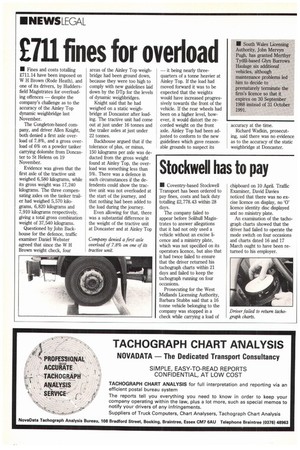£111 fines for overload
Page 16

If you've noticed an error in this article please click here to report it so we can fix it.
• Fines and costs totalling 2711.14 have been imposed on W H Brown (Rode Heath), and one of its drivers, by Huddersfield Magistrates for overloading offences — despite the company's challenge as to the accuracy of the Ainley Top dynamic weighbridge last November.
The CongJeton-based company, and driver Allen Knight, both denied a first axle overload of 7.8%, and a gross overload of 6% on a powder tanker carrying dolomite from Doncaster to St Helens on 19 November.
Evidence was given that the first axle of the tractive unit weighed 6,580 kilograms, while its gross weight was 17,240 kilograms. The three compensating axles on the tanker trailer had weighed 5,570 kilograms, 6,820 kilograms and 7,910 kilograms respectively, giving a total gross combination weight of 37,540 kilograms.
Questioned by John Backhouse for the defence, traffic examiner Daniel Webster agreed that since the W H Brown weight check, four areas of the Ainley Top weighbridge had been ground down, because they were too high to comply with new guidelines laid down by the DTp for the levels of dynamic weighbridges.
Knight said that he had weighed on a static weighbridge at Doncaster after loading. The tractive unit had come out at just under 16 tonnes and the trailer axles at just under 22 tonnes.
Backhouse argued that if the tolerance of plus, or minus, 150 kilograms per axle was deducted from the gross weight found at Ainley Top, the overload was something less than 5%. There was a defence in such circumstances if the defendents could show the tractive unit was not overloaded at the start of the journey, and that nothing had been added to the load during the journey.
Even allowing for that, there was a substantial difference in the weight of the tractive unit at Doncaster and at Ainley Top — it being nearly threequarters of a tonne heavier at Ainley Top. If the load had moved forward it was to be expected that the weights would have increased progressively towards the front of the vehicle. If the rear wheels had been on a higher level, however, it would distort the recorded weight on the front axle. Ainley Top had been adjusted to conform to the new guidelines which gave reasonable grounds to suspect its accuracy at the time.
Richard Wadkin, prosecuting, said there was no evidence as to the accuracy of the static weighbridge at Doncaster.




































































































